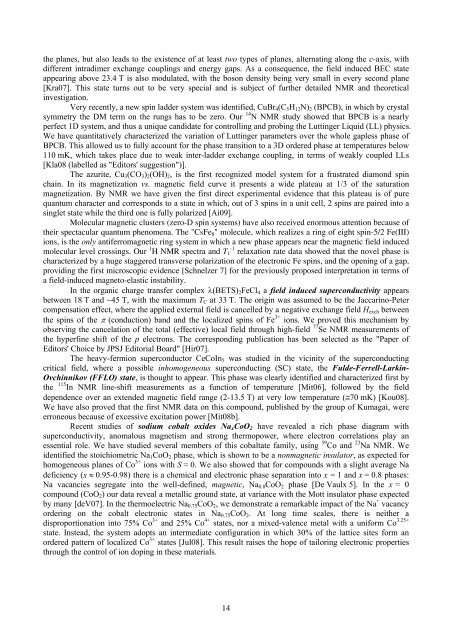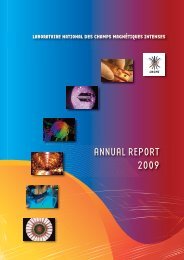Laboratoire National des Champs Magnétiques Pulsés CNRS – INSA
Laboratoire National des Champs Magnétiques Pulsés CNRS – INSA
Laboratoire National des Champs Magnétiques Pulsés CNRS – INSA
You also want an ePaper? Increase the reach of your titles
YUMPU automatically turns print PDFs into web optimized ePapers that Google loves.
the planes, but also leads to the existence of at least two types of planes, alternating along the c-axis, with<br />
different intradimer exchange couplings and energy gaps. As a consequence, the field induced BEC state<br />
appearing above 23.4 T is also modulated, with the boson density being very small in every second plane<br />
[Kra07]. This state turns out to be very special and is subject of further detailed NMR and theoretical<br />
investigation.<br />
Very recently, a new spin ladder system was identified, CuBr4(C5H12N)2 (BPCB), in which by crystal<br />
symmetry the DM term on the rungs has to be zero. Our 14 N NMR study showed that BPCB is a nearly<br />
perfect 1D system, and thus a unique candidate for controlling and probing the Luttinger Liquid (LL) physics.<br />
We have quantitatively characterized the variation of Luttinger parameters over the whole gapless phase of<br />
BPCB. This allowed us to fully account for the phase transition to a 3D ordered phase at temperatures below<br />
110 mK, which takes place due to weak inter-ladder exchange coupling, in terms of weakly coupled LLs<br />
[Kla08 (labelled as "Editors' suggestion")].<br />
The azurite, Cu3(CO3)2(OH)2, is the first recognized model system for a frustrated diamond spin<br />
chain. In its magnetization vs. magnetic field curve it presents a wide plateau at 1/3 of the saturation<br />
magnetization. By NMR we have given the first direct experimental evidence that this plateau is of pure<br />
quantum character and corresponds to a state in which, out of 3 spins in a unit cell, 2 spins are paired into a<br />
singlet state while the third one is fully polarized [Ai09].<br />
Molecular magnetic clusters (zero-D spin systems) have also received enormous attention because of<br />
their spectacular quantum phenomena. The "CsFe8" molecule, which realizes a ring of eight spin-5/2 Fe(III)<br />
ions, is the only antiferromagnetic ring system in which a new phase appears near the magnetic field induced<br />
molecular level crossings. Our 1 H NMR spectra and T1 -1 relaxation rate data showed that the novel phase is<br />
characterized by a huge staggered transverse polarization of the electronic Fe spins, and the opening of a gap,<br />
providing the first microscopic evidence [Schnelzer 7] for the previously proposed interpretation in terms of<br />
a field-induced magneto-elastic instability.<br />
In the organic charge transfer complex λ(BETS)2FeCl4 a field induced superconductivity appears<br />
between 18 T and ~45 T, with the maximum TC at 33 T. The origin was assumed to be the Jaccarino-Peter<br />
compensation effect, where the applied external field is cancelled by a negative exchange field Hexch between<br />
the spins of the π (conduction) band and the localized spins of Fe 3+ ions. We proved this mechanism by<br />
observing the cancelation of the total (effective) local field through high-field 77 Se NMR measurements of<br />
the hyperfine shift of the p electrons. The corresponding publication has been selected as the "Paper of<br />
Editors' Choice by JPSJ Editorial Board" [Hir07].<br />
The heavy-fermion superconductor CeCoIn5 was studied in the vicinity of the superconducting<br />
critical field, where a possible inhomogeneous superconducting (SC) state, the Fulde-Ferrell-Larkin-<br />
Ovchinnikov (FFLO) state, is thought to appear. This phase was clearly identified and characterized first by<br />
the 115 In NMR line-shift measurements as a function of temperature [Mit06], followed by the field<br />
dependence over an extended magnetic field range (2-13.5 T) at very low temperature (≅70 mK) [Kou08].<br />
We have also proved that the first NMR data on this compound, published by the group of Kumagai, were<br />
erroneous because of excessive excitation power [Mit08b].<br />
Recent studies of sodium cobalt oxi<strong>des</strong> NaxCoO2 have revealed a rich phase diagram with<br />
superconductivity, anomalous magnetism and strong thermopower, where electron correlations play an<br />
essential role. We have studied several members of this cobaltate family, using 59 Co and 23 Na NMR. We<br />
identified the stoichiometric Na1CoO2 phase, which is shown to be a nonmagnetic insulator, as expected for<br />
homogeneous planes of Co 3+ ions with S = 0. We also showed that for compounds with a slight average Na<br />
deficiency (x ≈ 0.95-0.98) there is a chemical and electronic phase separation into x = 1 and x = 0.8 phases:<br />
Na vacancies segregate into the well-defined, magnetic, Na0.8CoO2 phase [De Vaulx 5]. In the x = 0<br />
compound (CoO2) our data reveal a metallic ground state, at variance with the Mott insulator phase expected<br />
by many [deV07]. In the thermoelectric Na0.75CoO2, we demonstrate a remarkable impact of the Na + vacancy<br />
ordering on the cobalt electronic states in Na0.75CoO2. At long time scales, there is neither a<br />
disproportionation into 75% Co 3+ and 25% Co 4+ states, nor a mixed-valence metal with a uniform Co 3.25+<br />
state. Instead, the system adopts an intermediate configuration in which 30% of the lattice sites form an<br />
ordered pattern of localized Co 3+ states [Jul08]. This result raises the hope of tailoring electronic properties<br />
through the control of ion doping in these materials.<br />
14







